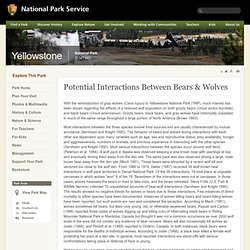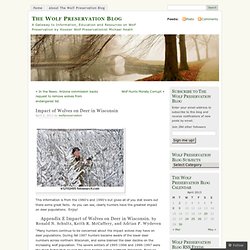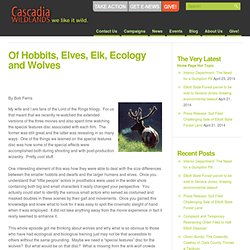

Reintroduced Wolves Killing Mountain Lions. Environment.

Yellowstone - Potential Interactions Between Bears & Wolves. With the reintroduction of gray wolves (Canis lupus) to Yellowstone National Park (YNP), much interest has been shown regarding the effects of a restored wolf population on both grizzly bears (Ursus arctos horribilis) and black bears (Ursus americanus).

Grizzly bears, black bears, and gray wolves have historically coexisted in much of the same range throughout a large portion of North America (Brown 1993). Most interactions between the three species involve food sources and are usually characterized by mutual avoidance (Servheen and Knight 1990). The behavior of bears and wolves during interactions with each other are dependent upon many variables such as age, sex and reproductive status, prey availability, hunger and aggressiveness, numbers of animals, and previous experience in interacting with the other species (Servheen and Knight 1990).
Most serious interactions between the species occur around wolf dens (Peterson et al. 1984). Literature Cited Brown, G. 1993. Haber, G.C. 1987. THE IMPACT OF WOLVES ON ELK HUNTING IN MONTANA. Full study, wolf bison interactions is yellowstone np.
This is a PDF of the full study. Click though the blank page to view it – ostarr
Impact of Wolves on Deer in Wisconsin. Impact of Wolves on Deer in Wisconsin April 2, 2013 by wolfpreservation This information is from the 1980′s and 1990′s but gives all of you stat lovers out there some great facts.

As you can see, clearly hunters have the greatest impact on deer populations. Enjoy! Of Hobbits, Elves, Elk, Ecology and Wolves. By Bob Ferris My wife and I are fans of the Lord of the Rings trilogy.

For us that meant that we recently re-watched the extended versions of the three movies and also spent time watching the special features disc associated with each film. The former was still great and the latter was revealing in so many ways. One of the things we learned on the special features disc was how some of the special effects were accomplished both during shooting and with post-production wizardry. Pretty cool stuff. One interesting element of this was how they were able to deal with the size differences between the smaller hobbits and dwarfs and the larger humans and elves. This whole episode got me thinking about wolves and why what is so obvious to those who have had ecological and biological training just may not be that accessible to others without the same grounding. That examination begins with looking at the long term elk population trends in Yellowstone’s northern range.
When 31 Canadian wolves were relocated to Yellowstone National. Interrelationships of Denali’s Large Mammal Community. 3.PDF. Ranchers, researchers test European dog breeds against wolves; Video: Maremma sheepdogs guard goats from coyotes near Terrebonne. Around the West traditional livestock guard dogs, such as the Great Pyrenees and Pyrenees mixes, have proven their worth in keeping coyotes and cougars away.

But federal researchers say they are not a match for larger predators — particularly wolves — so they are testing bigger dogs to see if they are better guard dogs. The researchers have shipped in dogs from Europe to see how well they guard sheep in Eastern Oregon from wolves and other predators. “The best way to find out if these dogs work is to try them,” said Julie Young, a research wildlife biologist at the National Wildlife Research Center in Logan, Utah. U.S.
Department of Agriculture Wildlife Services / Courtesy photo A Kangal guard dog leans against Ben Hober, of Montana. Ryan Brennecke / The Bulletin. CDPNews - MedWolf (EN) Research model unlocks secrets of wolf pack behavior. (Phys.org) —A team of researchers with members from AEPA Euskadi in Spain and Hampshire College in Massachusetts has developed a computer model that shows that wolf pack behavior depends on the social structure of the pack as well as its size.

In their paper published in Journal of the Royal Society: Interface, the team describes how their model works and what it shows regarding wolf pack behavior, particularly while hunting. For perhaps thousands of years, people have known of the terrifying skill of wolf packs when hunting for prey. Victims are encircled, giving them no place to run while wolves in the pack take turns rushing in for the kill. What's not as well-known is pack dynamics, particularly when hunting is taking place.
This lion doesn’t run, instead kills, eats wolf - Jackson Hole News&Guide: Environmental. Wild-eyed research cat stripped lobo to the bone, researcher says.

Posted: Wednesday, December 11, 2013 12:15 am This lion doesn’t run, instead kills, eats wolf By Mike Koshmrl Jackson Hole News&Guide | Five mountain lion cubs mothered by Teton Cougar Project research animals have met their ends in the jaws of wolves over the past few years. Now a Jackson Hole female cougar appears to have exacted vengeance. An online service is needed to view this article in its entirety. Need an account? A lion tracked by the Kelly-based science institute for the past six years is documented to have recently dined on a yearling wolf, Cougar Project biologist Mark Elbroch says. “What’s nice about this particular incident is that this is a collared mountain lion, and we know for sure that she killed it,” Elbroch said. The wolf-killer, known as F109, is a 101-pound female that lives in the Gros Ventre River headwaters. A bloody scene, and a surprise “There were wolf tracks everywhere,” he said.